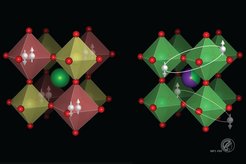Discovery of new perovskite antimonate superconductor unveils the role of oxygen holes in its sibling, high-Tc bismuthate superconductor
Scientists from the Max Planck Institute for Solid State Research, led by Minu Kim, the leader of the high-pressure synthesis group in the Department of Quantum Materials (Takagi), announced their discovery of superconductivity in new perovskite antimonates, Ba1-xKxSbO3 (BKSO), in collaboration with University of British Columbia (Canada), ISIS facility (U.K.), Canadian Light Source (Canada), University of Saskatchewan (Canada) and The University of Tokyo (Japan). The discovery allowed the team, via a comparative study of the electronic phase diagram with sibling compounds, Ba1-xKxBiO3, to address long-standing questions on the mechanism of high transition temperature, Tc, in a class of perovskite superconductors.
In the long sweep of history of superconductors, hole-doped perovskite bismuthates, Ba1-xKxBiO3 (BKBO), have held a unique position. In spite of a relatively low electronic density of states at the Fermi level, BKBO shows a maximum Tc of as high as ≈30 K (−243 ºC), which is the second highest among all oxides, the highest being the cuprates. Upon chemical substitution, superconductivity arises next to a charge-density-wave (CDW) insulating phase in the parent material, BaBiO3 (BBO). Several decades have passed since this discovery; however, the key ingredients for the enhanced Tc were yet to be clarified and remained the subject of big debate.

Early studies emphasized the role of metal cation Bi with the formal valence of 4+. Bi4+ ions with 6s1 configuration are known to be prone to a charge disproportionation into Bi3+ (6s2) and Bi5+ (6s0), often called “valence skipping”. Two electrons occupying the 6s orbital of Bi3+ were proposed to cause an electron paring in the real space in BBO and, more importantly, in the momentum space in metallic BKBO. The latter was anticipated to promote Cooper pairing and hence superconductivity in BKBO. An alternate picture emerged recently, which instead emphasized the role of oxygen instead of Bi, describing BKBO as an oxygen metal. The energy to transfer electrons (charges) from oxygen 2p to Bi 6s orbitals is “negative” in BKBO. This implies charge transfer from oxygen to Bi, resulting in fully occupied Bi 6s and partially occupied oxygen 2p orbitals that is responsible for conduction. The predominant oxygen-hole character of conduction electrons was suggested to be an essential ingredient to achieve the high Tc.
Sb is the element right above Bi in the periodic table and an isovalent, 5s-analogue of Bi. From first-principles calculations done previously, the team recognized that BKSO, in stark contrast to BKBO, likely has a small but positive oxygen-to-metal charge-transfer energy and therefore a drastically reduced oxygen-hole character. BKSO should serve as an extremely useful reference to clarify the role of oxygen holes in BKBO. Unfortunately, BKSO had never been synthesized before, under ambient pressure. Utilizing the high-pressure synthesis facility at MPI-FKF, which can provide a high-pressure and high-temperature environment up to P = 20 GPa and T = 2000 ºC, the team succeeded in stabilizing these perovskite antimonates for the first time.
The break-through in the synthesis of BKSO allowed the team to establish the electronic phase diagram as a function of potassium concentration and to compare it with that of BKBO. Despite the distinct positive sign of oxygen-to-metal charge transfer, the team discovered an enhanced CDW order in BaSbO3 (x = 0) with clear signature of the charge disproportionation into Sb3+ and Sb5+, and an insulator-to-metal transition via collapse of the CDW upon potassium substitution at a much larger critical potassium concentration (xc = 0.65) than is found for BKBO (xc = 0.4). Superconductivity is present in the metallic phase (x ≥ xc), with the maximum Tc = 15 K at xc = 0.65 in BKSO being even higher than Tc ≈ 7 K in BKBO at a comparable K composition x = 0.66. However, this is appreciably lower than the maximum Tc ≈ 30 K in BKBO where the CDW can be suppressed at a much lower xc = 0.4. If the suppression of the CDW state in BKSO could be realized at similar dopant concentrations to those required to suppress the CDW in BKBO, then the maximum Tc could have been even higher than 30 K.
The discoveries imply that the dominant oxygen-holes character (negative charge transfer energy) of conduction electrons in BKBO is not a necessary condition for achieving the high-Tc superconductivity but may contribute in part to enhance the maximum Tc within BKBO by weakening the competing CDW phase against K substitution. The delivered messages provide a fresh perspective on this old-but-new problem of understanding the origin of superconductivity in BKBO and present an exciting avenue for further theoretical and experimental studies.
We gratefully acknowledge Uwe Engelhardt and Frank Falkenberg for experimental support in high-pressure synthesis.











